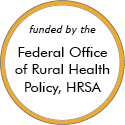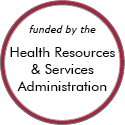Rural Project Examples: Care coordination
Promising Examples
SASH® (Support and Services at Home)
Updated/reviewed April 2025
- Need: In Vermont, the growing population of older adults, coupled with a lack of a decentralized, home-based system of care management, poses significant challenges for those who want to remain living independently at home.
- Intervention: SASH® (Support and Services at Home), based in affordable housing and their surrounding communities throughout the state, works with community partners to help older adults and people with disabilities receive the care they need so they can continue living safely at home.
- Results: Compared to their non-SASH peers, SASH participants have been documented to have better health outcomes, including fewer falls, lower rates of hospitalizations, fewer emergency room visits, and lower Medicare and Medicaid expenditures.
Nurse Navigator and Recovery Specialist Outreach Program

Updated/reviewed December 2024
- Need: To properly address and treat patients who have concurrent substance use disorders and chronic healthcare issues.
- Intervention: A referral system utilizes community health workers (CHWs) in a drug and alcohol treatment setting. A registered nurse helps with providers' medication-assisted treatment programs.
- Results: This program has reduced hospital emergency visits and hospital readmissions for patients since its inception.
Arkansas Rural Health Partnership Hospital-based Transitional Care Program

Added July 2024
- Need: Solutions for Medicare beneficiaries' post-acute care recovery gaps in Arkansas's southeast Delta Region.
- Intervention: Supported by federal funding and their membership organization, seven hospitals implemented an evidence-supported Critical Access Hospital transitional care model.
- Results: Participating hospitals found a significant increase in swing bed services revenue, an all-cause low readmission rate, high percentage of patients discharged to home or to an assisted living environment, and positive patient satisfaction surveys.
Maryland Faith Health Network
Updated/reviewed December 2022
- Need: To coordinate formal and informal community-based caregivers for optimal patient experience.
- Intervention: The Maryland Faith Health Network unites places of worship and healthcare systems in Maryland. This program aims to decrease the amount of potentially avoidable hospitalizations, improve a patient's overall wellness, and cut down on the cost of medical services.
- Results: This model is currently running in 3 hospitals that serve both rural and urban residents in central Maryland. So far, 1,300 congregants from 70 congregations representing Christian, Jewish, and Muslim faiths have enrolled in the Network.
Other Project Examples
COPD Readmission Prevention Program
Updated/reviewed August 2025
- Need: Organized focus on COPD patients' medical needs to decrease hospital readmissions in a rural Ohio healthcare system.
- Intervention: Creation of an integrated system model with nurse navigators central to evidence-based chronic disease care management approaches to COPD care.
- Results: Since its creation in 2014, the model continues to mature its comprehensive approach to provide optimized acute and chronic care for the area's COPD patients.
Queen Anne's County Mobile Integrated Community Health (MICH) Program
Updated/reviewed May 2025
- Need: To connect patients to resources in order to reduce use of emergency services, emergency department visits, and hospital readmissions.
- Intervention: Patients receive support (by in-person visit, phone call, or telehealth visit) from a paramedic, community health nurse, peer recovery specialist, and pharmacist.
- Results: Between July 2016 and March 2024, the program made 1,098 patient contacts and continued to see a reduction in emergency department and inpatient visits and costs.
Northern Light Health Accountable Care Organization
Updated/reviewed April 2024
- Need: To implement coordinated, integrated, and holistic healthcare to improve patient health and engagement and to reduce the overall cost of medical services in Maine.
- Intervention: The Northern Light Health ACO network launched with a focus on patient-centered care to improve overall wellness, reduce healthcare costs, and improve patient engagement and quality.
- Results: Through care coordination, Northern Light Health is enhancing provider efficiency and supporting a team approach to delivering care, leading to improved patient engagement and healthcare quality, and lowering the overall cost of care.
Outer Cape Health Services Community Resource Navigator Program

Updated/reviewed March 2023
- Need: Improving outcomes for Outer and Lower Cape Cod residents in need of social, behavioral health, and substance use disorder services while reducing the burden and costs to town agencies and hospital emergency rooms.
- Intervention: The Community Resource Navigator Program works with local social services, town agencies, faith-based institutions, hospitals, the criminal justice system, and others to identify and connect clients to needed services.
- Results: Clients are gaining access to the care they were once lacking, as measured by improvements in self-sufficiency. The program also helps community partners and stakeholders work together to reduce the impact of risks associated with behavioral health symptoms, substance use disorder, and social determinants of health.
Avita Health System Comprehensive Cardiology Program
Added April 2021
- Need: Population health approach to decreasing area deaths from cardiovascular disease.
- Intervention: A health system-level investment in level II cardiac catheterization services and the required specialized cardiology workforce.
- Results: Since August 2018, the Avita Health System in north central Ohio has provided local cardiovascular services that have decreased hospital transfers, increased care coordination, and provided education and prevention activities that, with time, will impact population health cardiovascular outcomes.
For examples from other sources, see:
